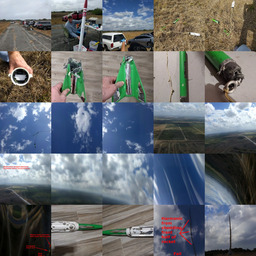   |
| Likes |  | ||
| Rocket | Panda 1 | ||
| Launches | 1 | ||
| Flight Status | Fail | ||
| Location | LaBelle | ||
| Event |
| ||
| Altitude | 1098 ft 334.67m | ||
| Expected | 10600 ft 3230.88m | ||
| Velocity Exp. | 890 MPH 1432.90km/h | ||
| Gs Expected | 19.6 | ||
| Weight | 4.18lb. 1.90kg | ||
| Stage | Motor | ||
| 1 | K513-FJ |
Panda-Failure
2021-02-06 18:39:00ZInsane Rocketry

 launch210206_130116_337.csv
launch210206_130116_337.csv Stratologger

 PandaStratologger20200207.pf2
PandaStratologger20200207.pf2 Description
Fincan, motor casing, all electronics and parts recovered except for the carbon fiber tube just above motor- which I believed was crushed on impact. Components recovered are damaged, but amazingly intact.
---
Update: I have reviewed the flight data and the deployment software I wrote performed nominally so original assessment was incorrect.
What I have:
Primary computer (my software)
- 1 unspent charge for main parachute - so it couldn't have fired.
- Could not find charge for drogue parachute.
- Software would have fired charges with proper sequence, rescuing bay from coming down at terminal velocity.
- Drogue chute is ripped off, as is nymex chute protector(only small corner remains).
Backup computer:
- Drogue charge fired and is spent. Amps appear to reflect it did fire at that time, but there's no guarantee.
- Drogue ->Perfectflite software says it fired 8.95 seconds into flight, long after catastrophic event.
- Main charge no where to be found. Perflight says there was no amps on attempted fire 14.1 seconds, which makes sense as the wiring was ripped and stayed with lower half of rocket.
Main Parachute:
- Still wrapped nicely, connected to bent eyebolt with motor/fins.
- Masking tape z tie wrappings intact. This means main did not deploy, not even a partial deploy. This is why I know main parachute section went up with the motor. Looking at the rocket, and following from the bottom, above the fins, you'll see a gray ring. Above that is the main parachute storage section (green and silver).
- I'm guessing that the main parachute tube was crushed on impact with rocks. The person that found my rocket did not say anything about that section, but I see debris on the front of the motor reinforcing this fact.
Assessment:
- With drogue chute and nymex protector ripped off of shock cord, I believe it had to have fired while still connected to the motor. If it had fired after separation (data shows software would have fired it ~5 seconds after catastrophic event), once bay reached it's own mini-apogee, forces would have been much less and the chute protector and/or drogue chute would have been intact.
- Unlikely caused by structural failure. I don't see how this could be the case based off the pieces I got back, but I can't rule it out. The pieces I have are extremely strong, even in their damaged state. I see no breakage or cracking indicating structural failure. While ugly, the pieces I have could fly right now.
- Highly likely: Wiring short, short-circuit, static, misfire, solder flake short. At the time of failure, there was 20gs of stress on the entire rocket. I'll try to recreate the conditions at launch by applying pressure on the electronics with my hands and see if I can get it to fire drogue.
- I was using an arduino add-on module designed by a friend. I directly soldered the arduino module to it. I also had to solder components to it. When testing, it worked great but I should have inspected it deeply with magnifying glass for solder debris. One flake coming off at high load and shorting wires on the circuit-board could easily do this.
Data:
- Failure happened 1.1 seconds after takeoff. Visual as well as G telemetry data confirm this.
- Rocket was under high G, but velocity was not transonic at 452 mph.
- Altitude was low at 342 feet AGL, but not one person saw the failure. All eyes were on the fins+motor making proper ascent.
- Even disconnected and drogue shock cord deployed, forces at play threw the bay to 1098 feet, 5.3 seconds into flight. Readings were very stable for barometer at apogee. My software instructed drogue deployment to occur here, but it had already deployed from hardware glitch.
- 8.95 seconds into launch backup computer fired drogue, we actually heard this pop and it confused us.
Further assessment 2020-02-12:
- Drogue deployment is highly likely the cause of failure. After inspecting telemetry and seeing event of when software told drogue to deploy (4.2 seconds after catastrophic event), software was not the cause. A short-circuit, short, static, cold solder-joint, solder flake, etc. caused the failure.
- Prior to frame by frame onboard imagery analysis, I was questioning if I had some type of physical part (like coupler, body tube, etc) failure. But now I see all the signs. Additional supporting evidence is found in the parts that broke due to the forces at play from drogue deployment.
- Now that I know what happened, the next step is to see if I can re-create the conditions.
Physical changes due to fail:
- While I don't know if it would have helped in this case, I'll create a kevlar loop around the electronics bay with the intent to keep the entire rocket together. This is the first rocket where I did not do this due to strength in bay and coupler/bulkhead components.
7th Launch with phone controlling rocket ignition via 900MHz band.











































Comments
Wow, even the eyebolt got bend !! That's incredible powerful forces going on there !! Hope it can be fixed and fly again.
Jason, are you planning to launch this rocket again in the same configuration ??? After a full inspection and complete check out ?
If I can't figure out what exactly what went wrong, configuration will be drastically different. If I DO figure out what went wrong, configuration will still change as things should never come down ballistic.
frewi80 on 2021-02-09 21:31:43Z wrote:
To further eliminate software edge cases as possible cause of the problem, I recreated exact configuration of rocket, phone, GoTenna mesh, and bluetooth launch system controlled by onboard phone.
I tested many scenarios on countdown / ignite rocket and could not duplicate via software the failure.
In my testing, I even abruptly powered down the launcher to simulate bluetooth device instantly getting out of range of phone because phone launches on rocket whereas bluetooth launcher stays on ground.
No software failures occurred.